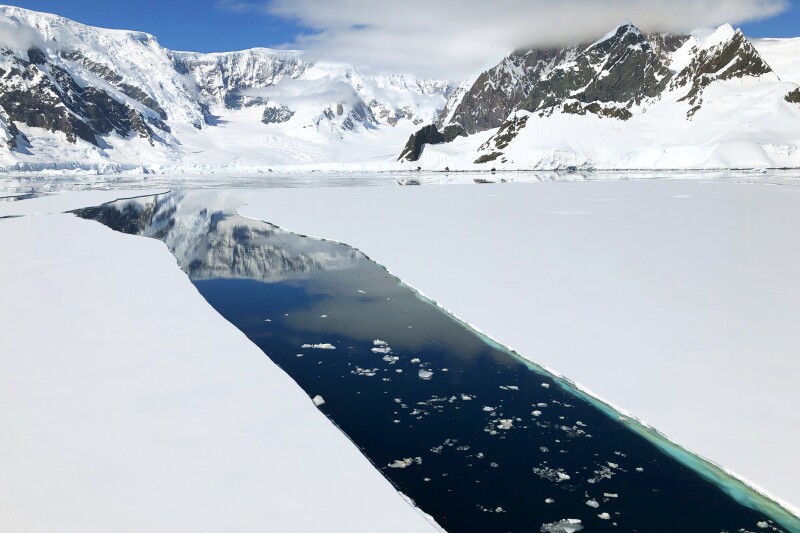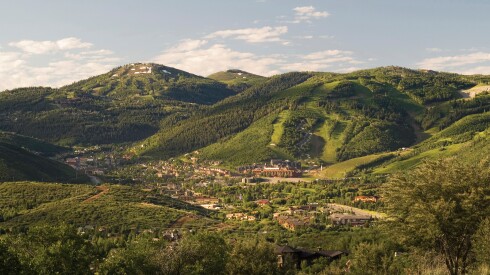Ernest Shackleton, forgive me.
I’ve sipped champagne on an ice floe in Wilhelmina Bay.
I’ve savored a croissant while watching penguins porpoise through glinting Antarctic waves.
I’ve even received a full-body massage from a French therapist with an iron grip while our ship sailed smoothly across the Drake Passage.
Before my 11-day expedition cruise to Antarctica with the French cruise line Ponant, I had read the journeys of great polar explorers. I knew that Shackleton spent 497 days trapped at sea before crossing the passage—one of the world’s most notorious bodies of water—in nothing but a 23-foot lifeboat. I knew that long-distance swimmer Lynne Cox swam more than a mile (without a wet suit!) in frigid Antarctic waters in 2002. And I knew that the late polar explorer Henry Worsley and his team faced debilitating whiteouts, hidden crevasses, and near-constant fatigue on their pioneering two-month trek through the Transantarctic Mountains in 2008.
In short, I was ready to suffer. I expected to suffer. I wanted to suffer.

Guests hike on Deception Island, a caldera that last erupted in 1970.
Photo by Aislyn Greene
I arrived in Ushuaia, the southernmost city in Argentina and the launch point for most journeys to Antarctica, with a dozen different treatments for seasickness, approximately 45 layers of polar fleece and silk long underwear, and a healthy amount of fear.
But the only disconcerting thing about boarding Le Boréal, a gleaming, 132-cabin marvel of engineering, was how easy it was. I was immediately relieved of my luggage, handed a hot towel and a glass of champagne, and whisked to the passport station. Within 10 minutes I was standing in my cabin, admiring the spacious room and adjoining private balcony. In my mind, the ghost of Shackleton gazed at the plush surrounds, chuckled, and said, “You know that after the Endurance sank, my most prized possession was a spoon.”
The evening passed in a blur of bubbles, French cheeses, and new acquaintances. As we churned out of Ushuaia, I stood on the stern of Le Boréal, wrapped in my insulated, Ponant-issued red parka, a heated swimming pool rippling in the light behind me.

Under good weather conditions, there are plenty of opportunities to disembark from the Ponant vessel and explore.
Photo by Aislyn Greene
Later that night, I woke to the sounds of Le Boréal creaking and groaning, the ship rolling and pitching like a toy boat in Poseidon’s tub. I slid out of bed and staggered toward my balcony, pulling open the heavy glass door—engineered to create a watertight seal in case of flooding. Once outside, I peered into a darkness so fathomless I felt momentarily dizzy. There were no lights, nothing to ground my vision, just an ear-splitting wind and a cold so intense it immediately pushed me back inside. I crawled into bed, gripped by the knowledge that there were more than 11,000 feet of water between Le Boréal and the seafloor and hundreds of miles between us and land. And there again was the ghost of Shackleton, whispering the same rhythmic quote from The Rime of the Ancient Mariner that he’d whispered to himself on his first journey to Antarctica: “Alone, alone, all, all alone, alone on a wide wide sea.”
By morning, I felt decidedly less alone. The voices of happy mariners trickled in from the ship’s passageways. The skies had cleared, the seas had calmed. In fact, crackled Captain Christophe Colaris over the ship’s sound system, we had such good weather, we would reach the Antarctic Peninsula 12 hours early. Instead of the Drake Shake—a violent, spiteful sea where waves can reach as high as a four-story building—we’d encountered the Drake Lake, a tamed beast, with rolling aquatic hills that carried us sedately toward the White Continent.
I walked into the dining room to find a dizzying array of breakfast options, including a table practically sagging under the weight of French pastries: apple-filled turnovers, raisin-freckled buns, croissants shining with butter, all conjured that morning by our Parisian baker, Paul. As I chewed my chocolate croissant and nursed my café au lait, I couldn’t help but wonder: When would the misery begin?

When chunks of ice break off a glacier, it’s known as “calving.”
Photo by Aislyn Greene
Our first continental landing—Brown Bluff Beach, a windy stretch of rock and ice in the Antarctic Sound—had potential. The Zodiac ride from the ship to the shore was wild and bumpy. Suddenly we hit an especially rough patch and a rogue wave of salt water slapped me in the face. Icy water dripped down my cheek in numbing tracks. My face remained numb as the Zodiac neared the shore, where I was smacked by another wave, this time an olfactory one: a heady, unforgettable mix of penguin urine and guano. As we stepped onto Antarctic soil for the first time, I touched my nose to make sure it was still there. But before long, my body had warmed in the summer sun, and we passed the afternoon wandering the beach, the basalt cliffs towering above us, white petrels soaring in the distance, and all around us, penguins: orange-beaked gentoos and ring-eyed Adélies, waddling back and forth on snowy highways as busy and fascinating as the streets of New York. At our appointed hour, guides ushered us back to the ship, the ride smooth and dry.
The days passed in a similar sea of ease. On Deception Island, we hiked through the Mars-like terrain of a former whaling site—and still active volcano—trekking up and down dark hills sugared with snow. At every point where we could take a wrong, and potentially deadly, turn, there was a helpful, well-educated guide offering tips about the wildlife or geology while gently keeping us on course. We saw whales every night, a Disney-like spectacle of orcas with their calves and humpbacks nosing up to feed. The weather remained docile, allowing us to hike every day—to penguin rookeries on windy peaks, to a shore where the mammoth skeleton of a beached whale remained. “We never get this many continental landings,” exclaimed one seasoned guide.
One day, I felt the shudder of ship against ice. I scrambled to my balcony to see if maybe (maybe!) we’d hit an iceberg. Well, yes, we had—kind of. Turns out, our captain had intentionally anchored the ship on an ice floe, so that we travelers could set foot on a piece of untouched Antarctica. An hour later, I was standing on a five-foot-thick hunk of ice, clutching another glass of champagne as my cohorts took snow-angel selfies and a lone penguin crossed in the distance.

Among the ways to engage with the Antarctic landscape is an opportunity to walk on an ice floe like this one.
Photo by Aislyn Greene
On our last day in Antarctica, we took Zodiac tours of Paradise Bay, where we zoomed for hours through fields of ice. There were arcs as blue as the sky, and fat slabs home to lounging leopard seals, and in the water, a mosaic of perfectly clear chunks, diamonds bobbing in a gray sea. I was totally mesmerized. Well, almost totally. A tiny part of me hoped that a glacier would calve and capsize our Zodiac. It would be a brief capsize, righted quickly, and we’d be swiftly rescued and rewarmed. But I would have a story of near danger to carry home, to prove that I’d experienced, and survived, the true heart of Antarctica. Spoiler alert: We did not capsize. As I climbed back onto our beautiful ship, returned to my beautiful room, ate my beautiful meal, I was surprised to find I was a little deflated. And as we again crossed the relatively calm Drake Passage, I felt guilty that I felt deflated.
It was only months later, as I sat down to write this, that I finally brokered a truce with myself. OK, so maybe I didn’t contribute to the polar legacy, I admitted. Maybe I didn’t experience katabatic winds, or suffer frostbite, or get lost on Deception Island. But really, who was I kidding? I’m not a polar explorer. In fact, I hate being cold. I like a little pampering—and I love French pastries. The fact that someone like me—who, let’s face it, is a little soft—was able to travel to this fearsome, unforgiving, magnificent continent in utter safety and comfort is something of a miracle. And it’s because of all those people who suffered before me. So forgive me, Ernest. And thank you.

Zodiac tours during a Ponant expedition to Antarctica get travelers closer to the destination.
Photo by Aislyn Greene
How to do this trip Senior editor Aislyn Greene journeyed to Antarctica with the French cruise company Ponant, which offers multiple Antarctic expedition cruises each year, typically from November through March. The 11-day “New Year’s Day and the Magic of the White Continent” sailing—the trip featured in this story—offers the chance to celebrate the new year in Antarctic waters with passengers from around the world. From $13,990, all-inclusive (and yes, there’s a nightly French cheese buffet).
More Epic Trips From AFAR
—Why heli-hiking is the best way to see Canada’s pristine wilderness
—The Venice-Simplon-Orient-Express is a real-life time machine
—Adventure travel fantasy meets jungle reality on a trip to Borneo
—What we learned from the famously fearless creatures of the Galápagos
—This is the Kenya journey we all need to go on
—In New Zealand, you’ll always feel welcome
Looking for more? Follow us on Facebook and sign up for our Daily Wander newsletter for the latest travel news and inspiration.
>> Next: 11 Things I Wish I’d Known Before Traveling to Antarctica











